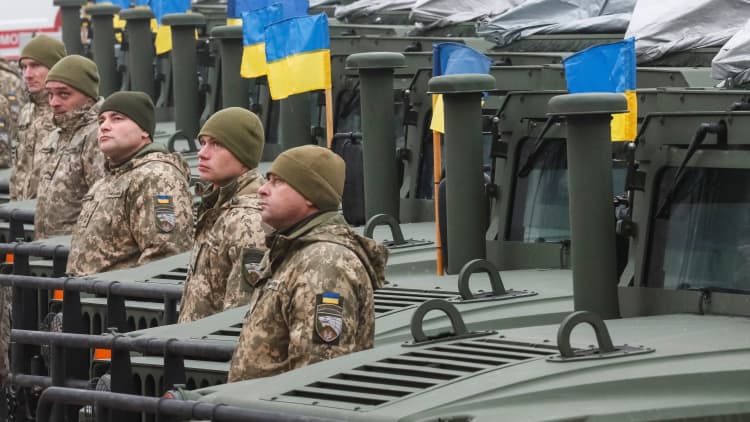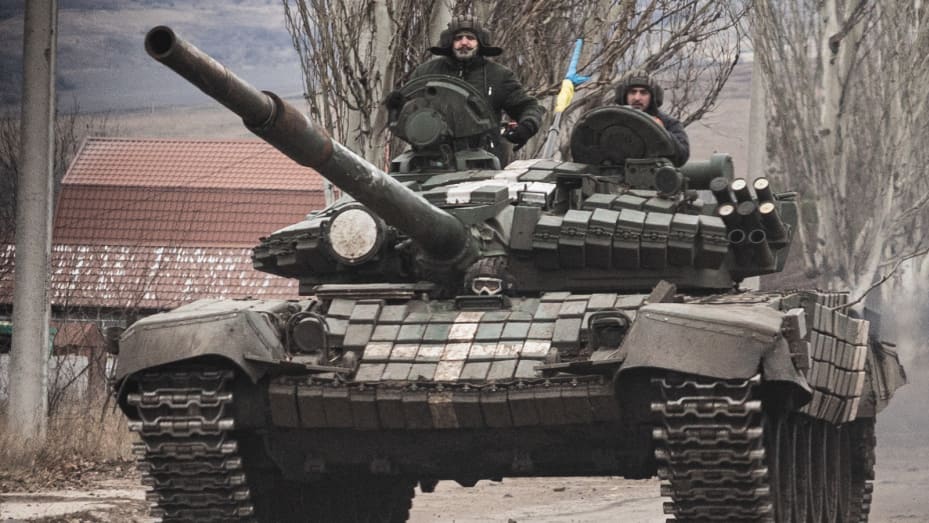Holly Ellyatt

Ukraine has repeatedly asked its Western allies to provide it with battle tanks to help it fight Russia and up until now, its Western allies appeared reluctant to do so.
That could be about to change, experts note, when Ukrainian officials and those from its Western allies meet later this week in Germany to discuss the country’s military needs.
The U.K. has already broken an impasse over the provision of tanks, announcing last week that it will send 14 Challenger 2s to Ukraine.
A new Leopard 2 A7V heavy battle tank, the most advanced version of the German-made tank.
Ukraine has repeatedly asked its Western allies to provide it with battle tanks to help it fight Russia but up until now, its Western allies appeared reluctant to do so, fearing the provision of offensive weapons could provoke Moscow further.
After months of pressure on the likes of Berlin and Washington to provide such hardware, however, that reluctance could be about to change, experts note, and some announcements could be made when Ukrainian and Western officials meet later this week in Germany to discuss the country’s pressing military needs.
“My understanding is that a deal has essentially been worked out,” John E. Herbst, senior director of the Atlantic Council’s Eurasia Center and a former U.S. ambassador to Ukraine, told CNBC Monday.
“We know that the laggard here has been Germany, and it seems that the Germans have now been persuaded that one, they’ll let other countries which have Leopard tanks send them to Ukraine — that, I’m confident of — and I also think it’s highly likely, but I’m not as confident, that you’ll see Germany send some Leopards as well,” he said.

Here are the three big issues facing Ukraine as a tough winter approaches
It’s almost a year since Moscow launched its ill-fated invasion of its neighbor and the war shows no signs of ending any time soon. Russian forces still largely occupy a swathe of territory to the east and south of the country where brutal, intense fighting continues, and much of Ukraine’s civilian infrastructure comes under daily bombardment.
While Ukraine has seen some notable victories on the battlefield, particularly with its counteroffensive in Kharkiv in northeast Ukraine that pushed Russian forces out of the region, the war has settled into an attritional rhythm as winter has set in, with Donetsk and the area around Bakhmut the epicenter of warfare that has been likened to World War I.
Spring offensives
Both sides are believed to be preparing for new, spring offensives and there are fears Russia is about to mobilize thousands more men to fight in Ukraine after Russian President Vladimir Putin signaled that he has the stomach for a long war.
Ukraine has repeatedly asked its allies for more weapons and those requests have largely been answered: the U.S., U.K. and NATO allies in Europe and beyond have sent Ukraine a wide range of military hardware from ammunition and artillery and air defense systems to infantry fighting vehicles with the U.S., France and Germany promising early in January to provide Bradleys, AMX-10 RCs and Marders, respectively.
Nonetheless, tanks have been a different matter with tanglible caution in the West over sending Ukraine what it wants — namely, the U.S.′ M1 Abrams tanks and Germany’s Leopard 2s that it believes would give it a significant advantage over Russia and be a big step up from the Soviet-era tanks it relies on now — amid concerns over stirring up further tensions with Russia and the logistical challenges providing modern Western tanks entails in terms of training and maintenance.
Last week, the White House again declined to say whether the U.S. would specifically provide Ukraine with main battle tanks.

U.S. soldiers fire from an M1 Abrams main battle tank.
The impasse over tanks seemed to break when the U.K. announced at the weekend that it would be sending 14 Challenger 2 tanks to Ukraine. It made it the first country to send Western-made battle tanks to Kyiv, while countries like Poland, Finland and the Baltic states have also openly endorsed re-exporting Leopard 2 tanks to Ukraine from their own stocks, but crucially require Germany’s permission to do so.
President Zelenskyy thanked the U.K. for its support, saying the decision would “not only strengthen us on the battlefield, but also send the right signal to other partners.”
Poland’s President Andrzej Duda reiterated his calls for Ukraine to receive more Western tanks when he appeared on a panel at the World Economic Forum in Davos, Switzerland, on Tuesday.
“We hope and we are trying to organize a bigger support for Ukraine so we hope that there are a few allies, partners, who will give tanks to Ukraine [like] Leopard tanks, Challenger tanks from Britain, so we hope that the producer of those tanks, Germany, will participate in what is, in my opinion, a very good idea,” he said.
For its part, Germany has been tight-lipped about tanks despite increasing pressure, and criticism, in this regard. German arms manufacturer Rheinmetall (which makes the main gun on the Leopard 2) tried to manage mounting expectations of a decision on tanks on Monday, with the chief executive of the firm telling a German newspaper that Leopard 2s from Germany’s industrial reserves would not be ready for any kind of delivery before 2024.
With the sudden resignation of Germany’s Defense Secretary Christine Lambrecht on Monday, her successor Boris Pistorius is likely to find the decision on tanks is top of his agenda.
The topic of tanks is expected to top the discussions when officials from Ukraine and allied countries meet at a “Ukraine Defense Contact Group” meeting on Friday in Germany, where they will look to coordinate efforts to provide further military aid to Ukraine.
Ahead of the predicted spring offensives by both Ukraine and Russia, analysts say the country needs heavy weaponry now more than ever and the donation of tanks, and the timing of any deliveries, could be pivotal.
“I think that the Germans eventually are going to cave and deliver these Leopard 2 tanks,” Samuel Ramani, a geopolitical analyst and associate fellow at the Royal United Services Institute, told CNBC Monday, noting that there had been “general movement towards supplying heavier artillery and battle tanks to the Ukrainian military.”

Ukrainian armed forces’ soldiers drive a T-72 tank on the outskirts of Bakhmut, eastern Ukraine on December 21, 2022.
A supply of modern Western tanks, Ramani believed, would “help undo one of Russia’s critical advantages in this war, which has been an overwhelming advantage in terms of artillery fire,” but he said the timing of any deliveries would be crucial.
“The timing is interesting. Will they arrive in time for the spring counteroffensive or will they arrive once Ukraine has shown more battlefield momentum and has proven itself to advance more strongly,” he asked.
“Ukraine right now has a resource dilemma between keeping forces in Bakhmut and relaunching and recalibrating forces for a counteroffensive,” he noted. If tanks took longer to be delivered, Ukraine might decide to keep its forces in Bakhmut in order to fight Russia’s advances on the city.
“Alternatively, they might scale back their presence in Bakhmut and cede some ground to the Russians in exchange for using this extra equipment to launch a faster, more comprehensive counteroffensive,” Ramani noted.
No comments:
Post a Comment